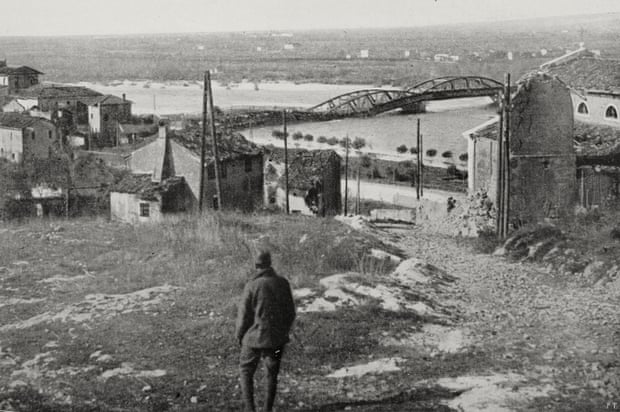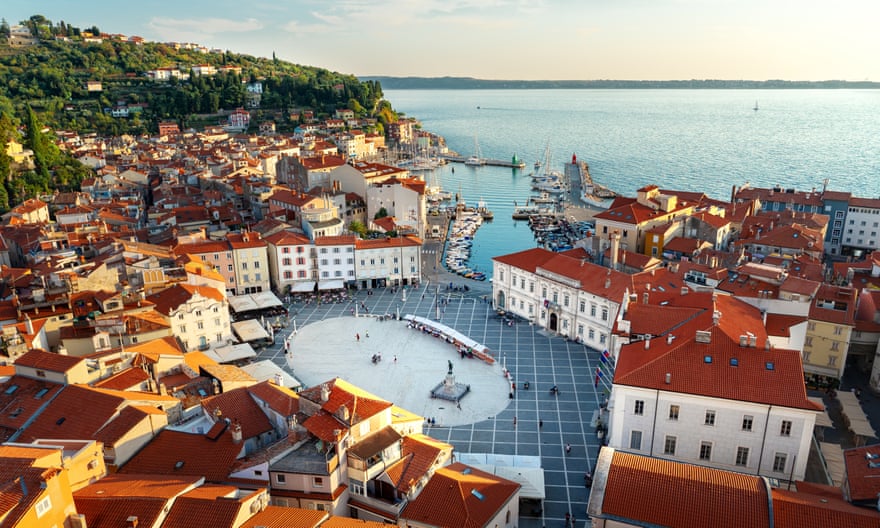We bump into Leon on a forested hillside overlooking the Slovenian town of Kobarid. It is the start of our bike ride and we are fiddling with saddle positions and checking tire pressures when he shows up. “Leave the bikes there,” he says. “There’s something you should see.”
A footpath leads up through the pines into a maze of old fortifications: trenches, tunnels, gun emplacements and lookout points. “This was the first world war frontline between the Italians and Austro-Hungarians,” Leon says to me and Jan, my cycle guide. It turns out that Leon is part of an organization that cares for the history of that war and has developed a long-distance footpath, the Walk of Peacewhich links historical sites.
From the hilltop behind the fortifications, a vast panorama opens up. Looking due south, the land dips through intricate valleys filled with vineyards and wooded ridges all the way to Trieste and the gleaming Adriatic Sea. To our left are limestone ridges that run into the forests of Croatia, and to the right, a coastline that disappears in a haze above which rise the jagged spires of the Italian Dolomites. Behind us stand the snow-capped Julian Alps and Austria.
Leon points that way, north, back down into the Soča Valley. “My family came from one village down there – for many generations. However …” He holds up four fingers and counts them off, “Grandfather was born in Austria-Hungaria, father in Germany, myself in Yugoslavia and my son in Slovenia.” It is the perfect reminder that our 200km route down to the coast along the Slovenia-Italy border is a route whose beauty comes with a checkered past. This ride, I realize, is going to be a whistlestop tour of European culture, history and politics, a tour made more poignant by recent events.
Eager to get started, we jump on our bikes and set off down the hill; a long, delightful swoop through ancient forests and tranquil villages. The road, empty of traffic, is dotted with fallen pine cones and sweet chestnuts, while the tough alpine villages are barricaded behind substantial, well-constructed log stacks. As we descend, the houses soon take on a softer Mediterranean look. Vines shade the patios and the trees are full of persimmons and lemons. Over the next three days we pass antique villages with ruined castles, stopping everywhere to sample a delicious array of local delicacies. The route, it transpires, is also a culinary delight.
We dip into Italy, crossing a line made invisible by the magic of the European Union, but when we are about to pass the empty customs post between Gorizia and Nova Gorica, Jan stops. There is a railway bridge immediately ahead of us, then Slovenia. Behind is Italy. Jan points to a distant tower block. “That is Šempeter hospital. Back in June 1991, I was a nine-year-old kid with meningitis and my bed was on the top floor overlooking this border post.”
On the morning of 28 June, Jan heard gunfire and looking out of his bedroom window saw tanks and soldiers moving around the customs post where we now stood. “The Slovenian pro-independence forces were fighting the Yugoslav national army right there on the border with Italy.”

In fact, what he then witnessed was the decisive battle of Slovenia’s 10-day war for independence. Two Russian-built T-55 tanks were knocked out and three others captured. It was a war in miniature by modern standards, but hugely significant for Slovenia.
We cycle onwards, thoroughly enjoying our superhuman ability to weave between Italy and Slovenia, stitching together what scheming warlords have spent centuries pushing apart. The land becomes abundant and fertile, the towns a mix of ancient architecture with stylish modern flourishes. We stop and chat with an older man out picking mushrooms, and drop in at a stonemason’s yard and an organic winery, the proud owner of which shows us his awe-inspiring cellar: three levels cut down into the karstic limestone and filled with 2,000- liter barrels of his best wines. To avoid causing offense we agree to sit down and eat generous portions of pršut, air-dried ham, and wash it down with several samples of his wines, all from autochthonous grapes: rebula, zelen, malvazija and teran.

The food and drink on this trip reflect the geographic diversity as we delve down from snowy peaks towards the sea. At Kobarid on my first night, at Hisa Polonka I had eaten pure mountain food, including geek, a kind of rösti, made with Tolminc cheese from high summer pastures. It was no surprise to learn that the owner, Valther Kramar, is married to Ana Roš, the chef at world-renowned Hisa Franko, a Michelin-starred restaurant also in Kobarid that also uses only local produce. Over the miles, we pedal and freewheel down through all the culinary strata: from the high alpine cheeses down through cherries, mushrooms, olive oil and oranges.
The reputation for great food is not new. In Štanjel, we chat to two locals: Uroš and Petra, born in nearby villages. “We just have a great climate for growing excellent ingredients,” says Petra. “In the 1930s, wealthy Italians would motor up here from Trieste to eat.”

That civilized tradition, however, was soon to be destroyed, as was Uroš’s own family. “When war broke out, German soldiers came here, hunting for partisans. My great-grandfather hid down a well, but was taken away, never to be seen again. We only learned in the 1960s that he had died in Dachau concentration camp. My grandfather, then 13 years old, was also taken away, but he reappeared after the war. He’d been conscripted as slave labor on a Bavarian farm.” Looking out on the tranquil hills around the village, it’s hard to imagine that cruelty and violence.
On the last day, a long descent through persimmon groves brings us to our final culinary zone: seafood. We park the bikes and eat fish on the harbor wall in Izola, a town with some lovely shady backstreets. This, however, is merely the hors d’oeuvres for our final destination, Piran, a colorful labyrinth of shady alleyways and courtyards, all wrapped around a little harbour.

Over the centuries, this town has been Roman, Venetian, Byzantine, Austrian-Hungarian and Napoleonic French. It has been both communist and fascist. But it has outlasted them all, preserving the air of a coastal port that rubs along with everyone. In the main square is a statue of Giuseppe Tartini, the violinist who was said to have sold his soul from him to Satan in return for the Sonata in G minor. Better that, I reckon, than all those devilish empires that have tramped through here, dragging along their tedious divisions of barbed wire and borders.
We eat mountains of seafood, sink cold beer and I vow never to leave Piran. The next day, I inadvertently set off back to the UK, but I hope to rectify this mistake before too long.
This trip was provided by the Slovenian Tourist Board. Slovenian hiking and cycling specialists Visit Good Place operates several cycle-touring trips, including a seven-night Alps to Adriatic route from €1,230 (based on two people sharing, includes breakfasts, baggage transfers, navigation pack and 24/7 support). Holiday Extras assisted with UK transfers and hotels
www.theguardian.com
George is Digismak’s reported cum editor with 13 years of experience in Journalism